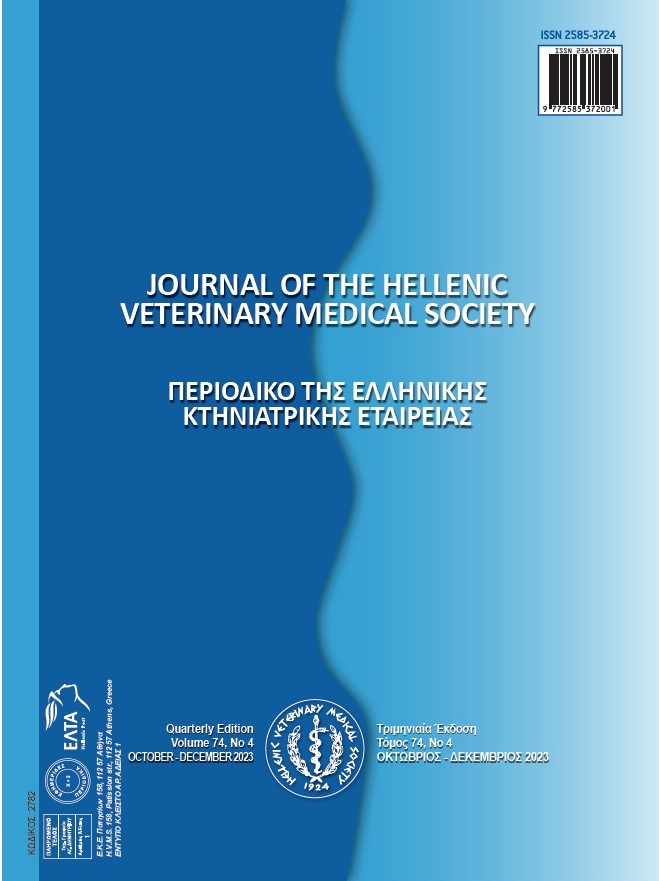Expression of steroidogenic enzymes in placentome of ewes with pregnancy toxemia after two parturition induction methods

Περίληψη
The regulation pattern of important enzymes in placental steroidogenesis and prostaglandins in ewes with pregnancy toxemia is reviewed. The alterations of gene expressions after the administration of aglepristone and dexamethasone are also discussed. Four healthy and 22 ewes with pregnancy toxemia were included to the study. Group AG (n=9) and Group DEX (n=9) in which ewes were injected twice with 10 mg/kg of aglepristone and once with 5 ml dexamethasone, respectively; whereas negative control [Group CG (n=4)] and pregnancy toxemia [Group PT (n=4)] groups received no treatment for parturition induction. Placentomes were collected either right after parturition or C-section. mRNA extraction from total placentome, caruncle, cotyledon and caruncle part of placentomes was carried out and Real-Time PCR was performed. Serum samples were collected and cortisol, PGFM, PGE2 and estrone sulfate concentrations were measured after treatments until parturition. The lowest mRNA expressions of steroidogenic enzymes were detected in group PT. Interestingly similar expression pattern of steroidogenic enzymes in group AG was as similar as group PT. No difference was found in expressions of 3βHSD and CYP19. PTGS2/COX2 and PGFS mRNA expressions were statistically different between groups AG-DEX and in caruncle between groups, respectively (P<0.005). Significant difference could clearly be observed in EP3 expression in caruncle of DEX and AG compared to CG (P<0.005); however PTGES, EP1, EP2 and EP4 expressions were not statistically different among groups (P>0,05). Ostrone sulfate, PGE2 and PGFM concentrations were statistically different according to the sampling time between groups however no difference was observed in cortisol. The present study has suggests that the endocrinologic pathway controlling parturition is clearly different in ewes with pregnancy toxemia. Spontaneous parturition could occur as a consequence of immune and inflammatory processes, which could be activated by by-products of fat metabolism. Dexamethasone applications has mimicked normal parturition, however the gene expression regulations, controlling uterine contractions, are observed as similar as group PT. Probably expressions of EP1 and tissue-specific counter-expressions of cervical EP genes could refer the pathogenesis of insufficient cervical dilatation, observed in pregnancy toxemia and dexamethsone applications.
Λεπτομέρειες άρθρου
- Πώς να δημιουργήσετε Αναφορές
-
Özalp, G., Ortaç , C., Bozkurt, B., Rişvanlı, A., Aktar , A., Yavuz, A., Korlu, Y., & Şeker, İ. (2023). Expression of steroidogenic enzymes in placentome of ewes with pregnancy toxemia after two parturition induction methods. Περιοδικό της Ελληνικής Κτηνιατρικής Εταιρείας, 74(2), 5505–5516. https://doi.org/10.12681/jhvms.26611
- Τεύχος
- Τόμ. 74 Αρ. 2 (2023)
- Ενότητα
- Research Articles

Αυτή η εργασία είναι αδειοδοτημένη υπό το CC Αναφορά Δημιουργού – Μη Εμπορική Χρήση 4.0.
Οι συγγραφείς των άρθρων που δημοσιεύονται στο περιοδικό διατηρούν τα δικαιώματα πνευματικής ιδιοκτησίας επί των άρθρων τους, δίνοντας στο περιοδικό το δικαίωμα της πρώτης δημοσίευσης.
Άρθρα που δημοσιεύονται στο περιοδικό διατίθενται με άδεια Creative Commons 4.0 Non Commercial και σύμφωνα με την άδεια μπορούν να χρησιμοποιούνται ελεύθερα, με αναφορά στο/στη συγγραφέα και στην πρώτη δημοσίευση για μη κερδοσκοπικούς σκοπούς.
Οι συγγραφείς μπορούν να καταθέσουν το άρθρο σε ιδρυματικό ή άλλο αποθετήριο ή/και να το δημοσιεύσουν σε άλλη έκδοση, με υποχρεωτική την αναφορά πρώτης δημοσίευσης στο J Hellenic Vet Med Soc
Οι συγγραφείς ενθαρρύνονται να καταθέσουν σε αποθετήριο ή να δημοσιεύσουν την εργασία τους στο διαδίκτυο πριν ή κατά τη διαδικασία υποβολής και αξιολόγησής της.








